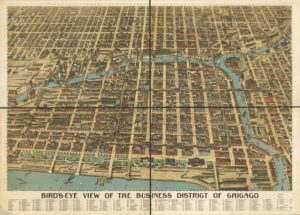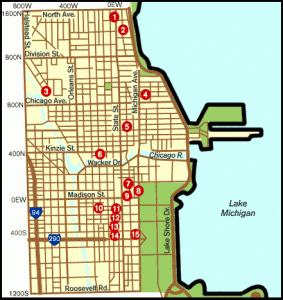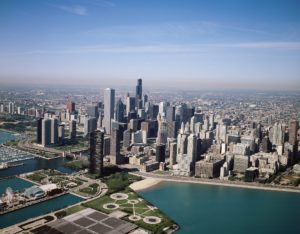Every city has its iconic boulevards, the streets that are home to history or feature in the addresses of soaring skyscrapers. Some of the most famous Chicago street names are well known—Michigan Avenue and its Magnificent Mile, the sweeping lake and city vistas on Lake Shore Drive—while others are notable primarily to local denizens.
For anyone considering traveling or living in the Windy City, here are some of the famed Chicago streets that define the metropolis:
 Michigan Avenue
Michigan Avenue
Michigan Avenue runs north–south a few blocks inland from the shoreline. Above all, N. Michigan Avenue is known for the Magnificent Mile, a thirteen-block stretch of high-end retail outlets that has gained worldwide renown. The moniker was coined by real estate developer Arthur Rubloff in 1947 as he began a revitalization plan for the section. As history attests, the ambitious title and transformation succeeded.
Michigan Avenue terminates just a few blocks farther north, where it becomes N. Lake Shore Drive as the shoreline expands westward. This area also happens to be home to The Clare, situated two blocks west of N. Michigan Avenue at the intersection of Rush and Pearson streets.
Michigan Avenue is a major thoroughfare south of the Magnificent Mile as well, forming the western border of Grant Park before narrowing south of Roosevelt Road.
Rush Street
Rush Street, a short, mostly one-way street just west of Michigan Avenue, has historic importance to the City of Chicago. Its southern end is capped by the Chicago River, and its northern edge folds into State Street above the Gold Coast District. Overall, it covers just less than a mile.
 Still, Rush Street has made its name in Chicago history, dating back to the 1830s, around the time of the City of Chicago’s incorporation. (It was named for Benjamin Rush, signer of the Declaration of Independence and prominent medical educator—Rush Medical College in Chicago was named in his honor.)
Still, Rush Street has made its name in Chicago history, dating back to the 1830s, around the time of the City of Chicago’s incorporation. (It was named for Benjamin Rush, signer of the Declaration of Independence and prominent medical educator—Rush Medical College in Chicago was named in his honor.)
The first mayor of Chicago lived on Rush Street, and its fashionable residences continue to be home to some of Chicago’s most prominent residents. High-end living is also reflected in elegant hotels and a vibrant nightlife.
State Street
State Street, another north–south corridor three blocks west of Michigan Avenue, anchors the Chicago Loop—a district of historic buildings, epic shopping, and engaging art installations. Two of its most notable features are the Great Clocks, also called the “Sentinels of State Street,” which are green, seven-ton timekeepers located at intersections with Randolph and Washington Streets. Other architectural and artistic highlights include the Tiffany Dome in the Chicago Cultural Center, the largest unbroken piece of Tiffany Favrile glass in existence, an astounding 1.6 million-piece blue, gold, and ivory mosaic.
Among all the shops, few have gained the attention of those on Jewelers Row, a collection of exceptional diamond and gem retailers that offer the largest selection in the Midwest.
 Lake Shore Drive
Lake Shore Drive
Look westward and take in the Chicago skyline. Turn your gaze to the east and enjoy a sunrise over Lake Michigan. Those views are the offerings of Lake Shore Drive, which runs along the eastern edge of Chicago, transporting visitors from the Lincoln Park Zoo southward, past Navy Pier, through Grant Park, and by the Shedd Aquarium, Field Museum, Solider Field, and beyond. In just a few miles, Lake Shore Drive provides a quick tour of the City of Chicago.
The Lakefront Trail that parallels the parkway is immensely popular, especially during warmer months. (Several Chicago footraces close portions of the parkway for runners—a unique opportunity.) Almost any stopping point provides immediate access to quintessential Chicago experiences.
Milwaukee Avenue
Not all of Chicago’s most famous streets are in the heart of the downtown area. Milwaukee Avenue, a diagonal road extending northwest out of the city, is the primary thoroughfare for the Wicker Park and Bucktown neighborhoods. The shops and restaurants that line Milwaukee Avenue have been featured in movies and television, though visitors are more likely to encounter one of the city’s best causal diners than the five-star cuisine common to downtown locales.
Milwaukee Avenue has strong connections with Chicago’s Polish community. Sometimes referred to as the “Polish Corridor,” Milwaukee Avenue retains a number of storefronts serving generations of Polish immigrants.
We’ll be the first to admit that this list isn’t comprehensive. There are always omissions in a city like Chicago. (Take Wacker Drive, for example, which follows the course of the Chicago River and is the street address for the 110-story Willis Tower.) Still, these famous Chicago street names capture the essence of the city and help orient visitors to Chicago’s must-see districts. Contact us today to learn more and schedule a tour.

 Michigan Avenue
Michigan Avenue Lake Shore Drive
Lake Shore Drive